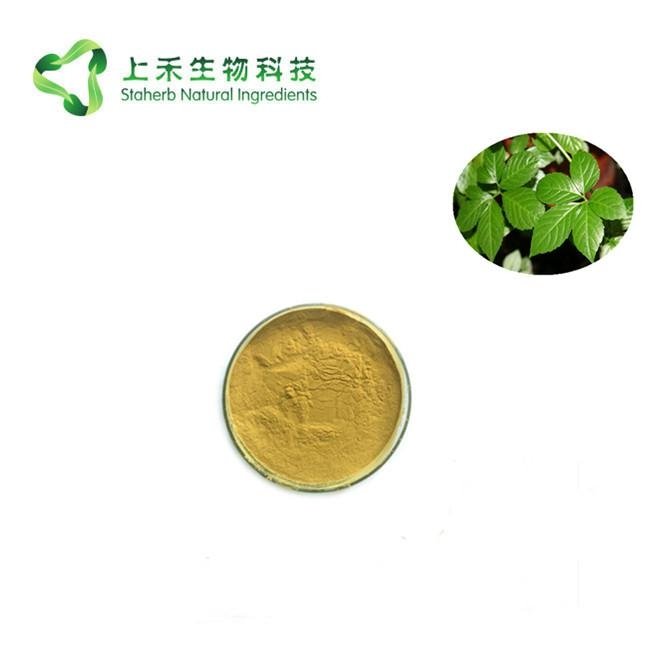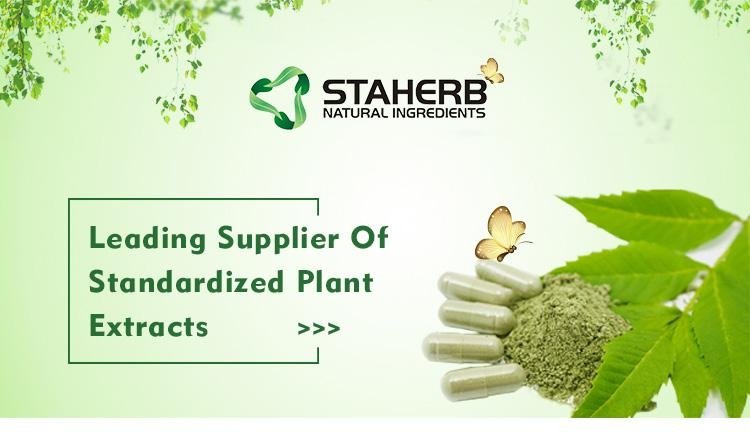
絞股藍提取物
中文名稱:絞股藍提取物
英文名稱:Gynostemma P.E.
CAS號:15588-68-8
分子式:C80H126O44
分子量:1791.83

絞股藍提取物是從絞股藍這種植物中分離出50余種絞股藍皂甙,和人蔘皂甙一樣,同屬於四環三萜類瑪皂甙。中醫學認為,絞股藍味苦、性寒,具清熱解毒、補氣、止咳、祛痰之功能。
從絞股藍中分離出50余種絞股藍皂甙,和人蔘皂甙一樣,同屬於四環三萜類瑪皂甙,其中絞股藍皂甙Ⅲ、Ⅳ、Ⅶ、Ⅻ分別和人蔘皂甙Rb1、Rb3、Rd、F2是同一物質,絞股藍皂甙元V-AH與人蔘皂甙Rg3相同,絞股藍皂甙I經過酶分解得人蔘皂甙K。藥理和臨床分解得人蔘皂甙K。
中文名稱:絞股藍提取物
英文名稱:Gynostemma P.E.
CAS號:15588-68-8
分子式:C80H126O44
分子量:1791.83
植物名稱:絞股藍,別名七葉膽、五葉參、小苦藥、公羅鍋底、小葉五爪龍等
規格:40% 80% 90% 98%
來源:葫蘆科植物,絞股藍Gynostemma pentaphyllum (Thunb.)Makino的乾燥全草。絞股藍別名七葉膽、小芍藥云、羅鍋底、遍地生根等。葫蘆科絞股藍屬多年生草質藤本植物。鳥趾狀復葉互生,卷鬚生于葉腋,小葉常5~7。花單性,,雌雄異株;花萼及花冠裂片5;雄花組成圓椎花序,花序軸纖細,多分枝,花絲短,聯合成柱,花藥着生于頂端;雌花為圓錐花序,較雄花序短小;子房下位,球形,2~3室,花柱3枚,短而叉開,柱頭2裂,漿果。
資源分布:全世界已知絞股藍有13種。我國占11種,廣氾分布天秦嶺以南的廣大省區。主要生長于海拔300-3200米的山谷密林、丘陵、山坡和石山地區的陰濕地帶。
產品性狀:絞股藍提取物為淡黃色粉末。
產品詳詢:13657416805
參考文獻:
1.Jiangsu New Medical College (1986) Dictionary of chinese traditional medicine. Shanghai Science and Technology Press, Shanghai (in Chinese)
-
2.Razmovski-Naumovski et al (2005) Chemistry and pharmacology of Gynostemma pentaphyllum. Phytochem Rev 4(2–3):197–219
-
3.Piao et al (2013) Dammarane-type saponins from heat-processed Gynostemma pentaphyllum show fortified activity against A549 cells. Arch Pharmacal Res 36(7):874–879
-
4.Flora of China Editorial Committee (2011) Flora of China, vol 19. Science Press, Beijing
-
5.Wang et al (2008) Genetic differentiation in endangered Gynostemma pentaphyllum (Thunb.) Makino based on ISSR polymorphism and its implications for conservation. Biochem Syst Ecol 36(9):699–705
-
6.Yu (2003) Artificial cultivation and processing of Gynostemma pentaphyllum. Guangxi Agric Sci 1:51–52 (in Chinese)
-
7.Bi et al (2000) Cultivation techniques of Gynostemma pentaphyllum. Lishizhen Med Materia Medica Res 11(2):191–192 (in Chinese)
-
8.Lu et al (2013) Chemical differentiation of two taste variants of Gynostemma pentaphyllum by using UPLC-Q-TOF-MS and HPLC-ELSD. J Agric Food Chem 61(1):90–97
-
9.Li et al (2012) Isolation and antitumor activities of acidic polysaccharide from Gynostemma pentaphyllum Makino. Carbohydr Polym 89(3):942–947
-
10.Circosta et al (2005) Cardiovascular effects of the aqueous extract of Gynostemma pentaphyllum Makino. Phytomedicine 12(9):638–643
-
11.Zhou (2010) Magic plant in the orient: Gynostemma pentaphyllum. Tea Health 7:50–52 (in Chinese)
-
12.Gu (2010) Southern Ginseng: Gynostemma pentaphyllum. Med People 10:43 (in Chinese)
-
13.Wang (2010) Longevity tea: Gynostemma pentaphyllum. Food Health 8:30–31 (in Chinese)
-
14.Ren (2006) Clinic research of total saponins of Gynostemma pentaphyllum in 80 hyperlipemia patients. Sichuan Med J 27(6):606–607 (in Chinese)
-
15.Zhang et al (2001) Clinic research of total saponins of Gynostemma pentaphyllum in hyperlipemia patients. Northwest Pharm J 16(3):130 (in Chinese)
-
16.Zhang et al (2007) Clinic research of gypenosides on renoprotective effects in patients with early diabetic nephropathy. Herald Med 26(11):1291–1294 (in Chinese)
-
17.Chiranthanut et al (2013) Toxicity evaluation of standardized extract of Gynostemma pentaphyllum Makino. J Ethnopharmacol 149(1):228–234
-
18.Zhang et al (2005) Experimental study on acute toxicity with dripping pills of Gynostemma pentaphyllum in mice. Nei Mongol J Tradit Chin Med 2:31 (in Chinese)
-
19.Attawish et al (2004) Chronic toxicity of Gynostemma pentaphyllum. Fitoterapia 75(6):539–551
-